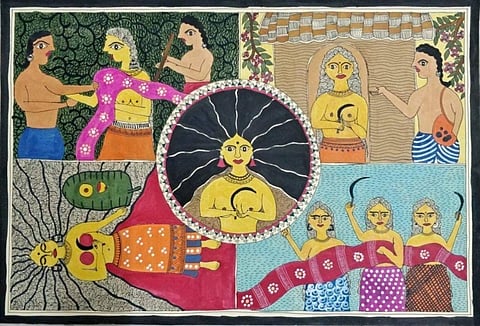
New Delhi- India, the land of rich art forms, is home to many varied styles of literature, and Godna is one of them. The art is a unique way of expressing emotions, distinct from the more well-known Mithila or Madhubani styles. In Madhubani art, often created by Brahmin women, one sees vibrant depictions of Hindu gods and goddesses. In contrast, Godna paintings, mostly made by Dalit Dusadh women, use black and white colors instead of bright ones.
The term "Godna" translates to ritual tattoo art, with the paintings typically portraying elements from nature, daily community life, or images of Dalit deities. This art form stands out not only for its visual distinctiveness but also for amplifying the voices of marginalized individuals. It offers a unique perspective on culture, spirituality, and everyday life, showcasing the creativity and diversity of different communities that goes beyond mainstream art.
The Mooknayak spoke with Rinku, a Dalit-Dusadh artist and researcher. She shared insights into her community, highlighting the prevailing casteism and misogyny within. Rinku has not only dedicated herself to community work but also focuses on her artwork, addressing various social issues.
Rinku shed light on the gendered roles ingrained within the community, impeding women from asserting ownership over their artistic creations. She expressed, “I used to live near Dilli-Haat, where many such stalls are set up, primarily by men. We often perceive these men as artists, but through my research, I realized they are not. They gain the money, recognition, and space, while the women who actually paint do not receive the same access.”
“It is the women from the Dusadh communities who create art, yet they lack rights to their own work. Men block their access, restricting women's mobility and opportunities. Take the example of Jitwarpur, also known as the craft village of Madhubani. Numerous national and state awardees hail from the village, but most women there are unaware of their compensation or pension. Although women are the primary earners, they lack access to the value of their labor. Even if they have access to their earnings, they hesitate to spend even a bit on themselves.”
As one of the first in her family to pursue higher studies, Rinku developed a keen interest in her community, leading her to extensive research. She shared, “During my research, I encountered firsthand experiences of caste and gender biases. Besides the unfortunate illiteracy prevalent among Dusandh community women, hindrances to interaction arise from ingrained gender norms. Moreover, men refused to engage with me due to my caste.”
“Online research revealed numerous articles on Mahbubani paintings but scarce information on the Dusadh community. People write about depictions of Ram-Sita but overlook the local deities painted by Dusadh women. Academic spaces, too, lack discourse on this art form. As the first person in my family pursuing a master's, I decided to base my research on the community and its art.”
Dusadh women employ Godna to express their community identity and artistic style. While Mithila paintings, which tell stories about Hindu gods like Rama and Sita, enjoy popularity, Godna represents a different artistic style. Unfortunately, Dalit Dusadh women have not received government support and were often prohibited from depicting Hindu gods or creating paintings like Kohbar that convey harmony and fertility. This exclusion persists; for instance, when beautifying the Madhubani railway station, Mithila art was included, but not Godna.
Godna art stems from the simple, everyday lives of Dalit Dusadh women. They start by handcrafting sheets of cloth or paper, washing them with a mixture of cow dung, glue, and water. For color, they use extracts from flowers and leaves or kohl. Many women purchase cow dung and glue from the market, incorporating the smell into their artwork, making it an integral part of their culture.
Rinku also disclosed her journey of self-acceptance. The Dalit researcher shared, “Accepting myself as a Dalit person was a process that only recently concluded. Since 2020, I consciously started identifying as a Dalit Dusadh feminist. It is crucial for me not to be labeled solely as a Dalit, as there are intersections of various castes, classes, and geopolitics within that.”
“As a woman, especially as a Dalit woman, we encounter issues everywhere. I approached feminist forums to discuss casteism and misogyny in folk art, detailing my personal challenges. However, I was told it is a personal problem. Yet, the personal is political. Mujhe dikkatein ho rahi hai kyuki meri pehchaan meri jism se judi hai (I am facing problems because my identity is stamped on my chest).”
History of the Dusadh Community: Dusadh is the second-largest scheduled caste group in Bihar, historically a rural community mainly found in Bihar, Jharkhand, Uttar Pradesh, Uttarakhand, West Bengal, Assam, Madhya Pradesh, and other states in India. Some members of this caste are also present in Haryana and Delhi. The Dusadh, also known as Dusad or Dosadh, constitute a large community of over two crore people scattered across various states in India. In the past, they were known for being palanquin bearers.
The Dusadh community is officially recognized as a Scheduled Caste under the Indian Constitution, listed in the Gazette of India on Friday, 11th August 1950, and categorized under Part II-Bihar 1(8).
You can also join our WhatsApp group to get premium and selected news of The Mooknayak on WhatsApp. Click here to join the WhatsApp group.